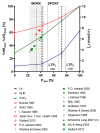The First Lactate Threshold Is a Limit for Heavy Occupational Work
- PMID: 33467281
- PMCID: PMC7739369
- DOI: 10.3390/jfmk5030066
The First Lactate Threshold Is a Limit for Heavy Occupational Work
Abstract
Long-term heavy physical work often leads to early retirement and disability pension due to chronic overload, with a need to define upper limits. The aim of this study was to evaluate the value of the first lactate threshold (LTP1) as a physiological marker for heavy occupational work. A total of 188 male and 52 female workers performed an incremental cycle ergometer test to determine maximal exercise performance and the first and second lactate (LTP1; LTP2) and ventilatory thresholds (VT1; VT2). Heart rate (HR) recordings were obtained during one eight-hour shift (HR8h) and oxygen uptake was measured during 20 minutes of a representative work phase. Energy expenditure (EE) was calculated from gas-exchange measures. Maximal power output (Pmax), maximal oxygen consumption (VO2 max) and power output at LTP1 and LTP2 were significantly different between male and female workers. HR8h was not significantly different between male and female workers. A significant relationship was found between Pmax and power output at LTP1. HR8h as a percentage of maximum HR significantly declined with increasing performance (Pmax:r = -0.56; p < 0.01; PLTP1:r = -0.49; p < 0.01). Despite different cardio-respiratory fitness-levels; 95.4% of all workers performed their usual work below LTP1. It is therefore suggested that LTP1 represents the upper limit for sustained heavy occupational work; which supports its use to determine work capability and assessing the limits of heavy occupational work.
Keywords: heavy work; individualization; intensity threshold; maximum oxygen uptake; work strain.
Conflict of interest statement
The authors declare no conflict of interest.
Figures





Similar articles
-
Influence of acute normobaric hypoxia on physiological variables and lactate turn point determination in trained men.J Sports Sci Med. 2014 Dec 1;13(4):774-81. eCollection 2014 Dec. J Sports Sci Med. 2014. PMID: 25435769 Free PMC article.
-
Intensity Thresholds and Maximal Lactate Steady State in Small Muscle Group Exercise.Sports (Basel). 2020 May 28;8(6):77. doi: 10.3390/sports8060077. Sports (Basel). 2020. PMID: 32481692 Free PMC article.
-
Different Heart Rate Patterns During Cardio-Pulmonary Exercise (CPX) Testing in Individuals With Type 1 Diabetes.Front Endocrinol (Lausanne). 2018 Oct 2;9:585. doi: 10.3389/fendo.2018.00585. eCollection 2018. Front Endocrinol (Lausanne). 2018. PMID: 30333794 Free PMC article.
-
Governmental regulations for early retirement by means of energy expenditure cut offs.Scand J Work Environ Health. 2012 Jul;38(4):370-9. doi: 10.5271/sjweh.3195. Epub 2011 Sep 14. Scand J Work Environ Health. 2012. PMID: 21918790
-
Determinants of oxygen uptake. Implications for exercise testing.Sports Med. 1997 Nov;24(5):308-20. doi: 10.2165/00007256-199724050-00003. Sports Med. 1997. PMID: 9368277 Review.
Cited by
-
Exercise duration: Independent effects on acute physiologic responses and the need for an individualized prescription.Physiol Rep. 2022 Feb;10(3):e15168. doi: 10.14814/phy2.15168. Physiol Rep. 2022. PMID: 35146958 Free PMC article.
-
Modeling Energy Expenditure Estimation in Occupational Context by Actigraphy: A Multi Regression Mixed-Effects Model.Int J Environ Res Public Health. 2021 Oct 3;18(19):10419. doi: 10.3390/ijerph181910419. Int J Environ Res Public Health. 2021. PMID: 34639718 Free PMC article.
-
Physical workload and cardiopulmonary parameters in relation to individual capacity of bulk waste workers - a cross-sectional field-study.J Occup Med Toxicol. 2023 Dec 15;18(1):29. doi: 10.1186/s12995-023-00389-z. J Occup Med Toxicol. 2023. PMID: 38102679 Free PMC article.
-
Multi-View Integrative Approach For Imputing Short-Chain Fatty Acids and Identifying Key factors predicting Blood SCFA.bioRxiv [Preprint]. 2024 Sep 27:2024.09.25.614767. doi: 10.1101/2024.09.25.614767. bioRxiv. 2024. PMID: 39386638 Free PMC article. Preprint.
References
-
- Holtermann A., Marott J.L., Gyntelberg F., Søgaard K., Suadicani P., Mortensen O.S., Prescott E., Schnohr P. Occupational and Leisure Time Physical Activity: Risk of All-Cause Mortality and Myocardial Infarction in the Copenhagen City Heart Study. A Prospective Cohort Study. BMJ Open. 2012;2:e000556. doi: 10.1136/bmjopen-2011-000556. - DOI - PMC - PubMed
LinkOut - more resources
Full Text Sources

